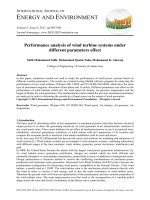- Trang chủ >>
- Khoa Học Tự Nhiên >>
- Vật lý
redox systems under nano-space control, 2006, p.302
Bạn đang xem bản rút gọn của tài liệu. Xem và tải ngay bản đầy đủ của tài liệu tại đây (7.95 MB, 302 trang )
Redox Systems Under Nano-Space Control
Toshikazu Hirao
(Editor)
Redox Sy stems
Under Nano-Space
C ontrol
With 133 Figures, 97 Schemes, 3 Structures and 19 Tables
123
Toshikazu Hirao
Department of Applied Chemistry
Graduate School of Engineering
Osaka University
Yamada-oka, Suita, Osaka 565-0871
Japan
e-mail:
Library of Congress Control Number: 2005937596
ISBN-10 3-540-29579-8 Springer Berlin Heidelberg New York
ISBN-13 978-3-540-29579-2 Springer Berlin Heidelberg New York
DOI 10.1007/b96698
This work is subject to copyright. All rights reserved , whether the whole or part of the material is concerned,
specifically the rights of translation, reprinting, reuse of illustrations, recitation, broadcasting, reproduction
on microfilm or in any other way, and storage in data banks. Duplication of this publication or parts thereof
is permitted only under the provisions of the German Copyright Law of September 9, 1965, in its current
version, and permission for use must always be obtained from Springer. Violations are liable for prosecution
under the German Copyright Law.
Springer is a part of Springer Science+Business Media
© Springer-Verlag Berlin Heidelberg 2006
Printed in Germany
The use of general descriptive names, registered names, trademarks, etc. in this publication does not imply,
even in the absence of a specific statement, that such names are exempt from the relevant protective laws
and regulations and therefore free for general use.
Product liability: The publishers cannot guarantee the accuracy of any information about dosage and
application contained in this book. In every individual case the user must check such information by
consulting the relevant literature.
Cover design: design & production GmbH, Heidelberg
Typesetting and production: LE-T
E
X J elonek, Schmidt & Vöckler GbR, Leipzig
Printed on acid-free paper 2/3141/YL - 5 4 3 2 1 0
springer.com
Redox Systems Under Nano-Space Control
Supramolecular chemistry has permitted a variety of conceptually novel ar-
tificial systems in various fields. Quite recently, the dynamic behavior is re-
quired by using the properties of these systems. From these points of view,
the construction of functionalized redox systems under nano-spac e control
appears to be essential for efficient electron and/or hole transfer in pio-
neering organic synthesis and nanostructured materials. For this purpose,
coordination-induced, metal-assembled, self-assembled, andmolecular chain-
induced highly regulated spaces in a nano level play an impor tant role through
fusion of t echniques in modern chemistry including supramolecular and bio-
inspired chemistry. This book consist of three parts: redox systems via d,
π-
conjugation,coordinationcontrol, and mole cularchain control,mainly dealing
with the precise synthesis of
π-conjugated and d,π-conjugated systems, metal-
lohosts, metal clusters, self-assembled monolayers and antibody systems, and
their application. Furthermore, the recent progress of rotaxanes and catenanes,
dendrimers, and star-shaped polymers is also described as important part of
this book. These systems are expected to achieve the dynamic redox functions
for highly selective and versatile electron-transfer reactions and functional-
ized nano-device materials. For future investigation, their functions should be
more beautiful. In this sense, I hope that this book will deepen the readers’
background and widen the scope of nanoscience.
Contents
Part I Redox Systems via d,π-Conjugation
1 Conjugated Complexes with Quinonediimine Derivatives
Toshiyuki Moriuchi, Toshikazu Hirao 3
1.1 Introduction 4
1.2 Architecturally Controlled Formation
ofConjugatedComplexeswith1,4-Benzoquinonediimines 5
1.3 Redox-Switching Properties of Conjugated Complexes
with1,4-Benzoquinonediimines 17
1.4 Conclusion 24
1.5 References 25
2 Realizing the Ultimate Amplification
in Conducting Polymer Sensors:
Isolated Nanoscopic Pathways
T imo thy M. Swager 29
2.1 DimensionalityinMolecular-WireSensors 29
2.2 Analyte-Triggered Barrier Creation in Conducting Polymers . . 32
2.3 Isola ted Nanoscopic Pathways 34
2.4 Langmuir–BlodgettApproachestoNanofibrils 34
2.5 MolecularScaffoldsfortheIsolationofMolecularWires 37
2.6 Summary and Future Prospects . 43
2.7 References 43
3 Metal-Containing
π-Conjugated Materials
Michael O. Wolf 45
3.1 Introduction 46
3.1.1
π-ConjugatedMaterials 46
3.1.2 Nanomaterials 46
3.2 Metal-Complex-ContainingConjugatedMaterials 47
3.2.1 Preparation 47
3.2.2 Properties 49
3.3 Metal-Nanoparticle-ContainingConjugatedMaterials 51
3.3.1 Preparation 51
VIII Contents
3.3.2 Properties 51
3.4 Applications 52
3.5 Conclusions 53
3.6 References 53
4 Redox Active Architectures andCarbon-Rich RutheniumComplexes
as Models for Molecular Wires
Stéphane Rigau t, Daniel Touchard, Pierre H. Dixneuf 55
4.1 Introduction 56
4.2 Ruthenium Allenylidene and Acetylide Building Blocks:
BasicProperties 57
4.2.1 SyntheticRoutes 57
4.2.2 RedoxProperties 60
4.2.2.1 Oxidation of Ruthenium Metal Acetylides:
Stable Ru
II
/Ru
III
Systems and a New Route
toAllenylideneMetalComplexes 60
4.2.2.2 Reduction of Metal Allenylidenes:
A ccess to Stable “Organic” Radicals and a Route to A cetylides . 61
4.3 Bimetallic Complexes from the Ru(dppe)
2
System 63
4.3.1 ABinuclearBis-AcetylideRutheniumComplex 63
4.3.2 Bis-Allenylidene Bridges Linking Two Ruthenium Complexes . 64
4.3.3 C
7
BridgedBinuclearRutheniumComplexes 67
4.4 Connection of Two Carbon-Rich Chains
withtheRutheniumSystem 71
4.5 Trimetallic and Oligomeric Metal Complexes
withCarbon-RichBridges 74
4.6 Star Organometallic-Containing Multiple Identical Metal Sites . 77
4.7 Conclusion 79
4.8 References 79
5 Molecular Metal Wires Built from a Linear Metal Atom Chain
Supported by Oligopyridylamido Ligands
Chen-Yu Yeh, Chih-Chieh Wang, Chu n-Hsien Chen,
Shie-Ming Peng 85
5.1 Introduction 86
5.2 SynthesisofOligopyridylamineLigands 87
5.3 DimerizationbySelf-ComplementaryHydrogenBonding 90
5.4 ComplexationofOligopyridylamineLigands 91
5.5 Mono-andDinuculearComplexes 91
5.6 StructuresofLinearMultinuclearNickelComplexes 92
5.7 StructuresofLinearMultinuclearCobaltComplexes 98
5.8 StructuresofLinearMultinuclearChromiumComplexes 100
5.9 StructuresofTrirutheniumandTrirhodiumComplexes 103
5.10 ComplexesofModifiedLigands 104
Contents IX
5.11 ElectrochemicalPropertiesoftheComplexes 105
5.12 Scanning Tunneling Microscopy Studies 112
5.13 Summary 114
5.14 References 115
6 Multielectron Redox Catalysts
in Metal-Assembled Macromolecular Systems
Takane I maoka, Kimihisa Yama moto 119
6.1 Introduction 119
6.2 MultielectronRedoxSystems 120
6.3 MultinuclearComplexesasRedoxCatalysts 122
6.4 Macromolecule-MetalComplexes 123
6.5 MetalIonAssemblyonDendriticMacromolecules 124
6.6 Conclusion 129
6.7 References 129
Part II Redox Sy s tems via Coordination Control
7 Triruthenium Cluster Oligomers
that Show Multistep/Multielectron Redox Behavior
Tomohiko Hamaguchi, Tadashi Yamaguchi, Tasuku Ito 133
7.1 Introduction 133
7.2 SynthesesofOligomers1and2 135
7.3 RedoxBehaviorof1and2 136
7.4 Conclusion 139
7.5 References 139
8 Molecular Architecture
of Redox-Active Multilayered Metal Complexes
Based on Surface Coordination Chemistry
Masa-aki Haga 141
8.1 Introduction 141
8.2 Fabrication o f Multilayer Nanoarchitectures
bySurfaceCoordinationChemistry 142
8.2.1 Layer-by-LayerAssemblyonSolidSurfaces 142
8.2.2 Molecular Design of Anchoring Groups
forControlofMolecularOrientationonSurfaces 143
8.2.3 M olecular Design of Redox-Active Metal Complex Units
fortheControlofEnergyLevelsonSurfaces 146
8.3 Chemical Functions
ofRedox-ActiveMultilayeredComplexesonSurface 148
8.3.1 ElectronTransferEventsinMultilayerNanostructures 148
X Contents
8.3.2 Combinatorial Approach
to Electrochemical Molecular Devices
inaMultilayerNanostructureonSurfaces 149
8.3.3 Surface DNA Trapping by Immobilized Metal Complexes
withIntercalatorMoietyTowardNanowiring 151
8.4 Conclusion 153
8.5 References 153
9 Programmed Metal Arrays by Means
of Designable Biological Macromolecules
K entaro Tanaka, Tomoko Okada, Mitsuhiko Shionoya 155
9.1 Introduction 155
9.2 DNA-DirectedMetalArrays 156
9.2.1 Metal-MediatedBasePairinginDNA 156
9.2.2 Single-Site Incorporation
ofaMetal-MediatedBasePairintoDNA 157
9.2.3 DiscreteSelf-AssembledMetalArraysinDNA 159
9.3 Peptide-DirectedMetalArrays 161
9.3.1 DesignConcept 161
9.3.2 HeterogeneousMetalArraysUsingCyclicPeptides 162
9.3.3 Metal Ion Selectivity in Supramolecular Complexation 163
9.4 Conclusion 164
9.5 References 164
10 Metal-Incorporated Hosts for Cooperative
and Responsive Recognition to External Stimulus
Tatsuya Nabeshima, Shigehisa Akine 167
10.1 Introduction 167
10.2 P seudomacrocycles
forCooperativeMolecularFunctionalSystems 168
10.3 Oligo(N
2
O
2
-Chelate) Macrocycles. 172
10.3.1 Design of Macrocyclic Oligo(N
2
O
2
-Chelate) Ligands
andMetallohosts 172
10.3.2 Synthesis and Structure of Tris(N
2
O
2
-Chelate) Macrocycles . . . 173
10.4 Acyclic Oligo(N
2
O
2
-Chelate)Ligands 174
10.4.1 Design of Acyclic Oligo(N
2
O
2
-Chelate)Ligands 174
10.4.2 Complexes of a New N
2
O
2
-Chelate Ligand, Salamo 175
10.4.3 Synthesis, Structure, and Properties
of Acyclic Oligo(N
2
O
2
-Chelate) Ligands . 176
10.5 Conclusion 177
10.6 References 177
Contents XI
11 Synthesis of Poly(binaphthol) via Controlled Oxidative Coupling
Shigeki Habaue, Bunpei Hata no 179
11.1 Introduction 179
11.2 Asymmetric Oxidative Coupling
withDinuclearMetalComplexes 181
11.3 OxidativeCouplingPolymerizationofPhenols 183
11.4 Oxidative Coupling Polymerization
of2,3-Dihydroxynaphthalene 184
11.5 Conclusion 188
11.6 References 188
Part III Redox Systems via Molecular Chain Control
12 Nano Meccano
Yi Liu, Amar H. Flood, J. Fraser Stoddart 193
12.1 Introduction 194
12.2 Redox-ControllableMolecularSwitchesinSolution 196
12.2.1 Bistable[2]Catenanes 196
12.2.2 Bistable[2]Rotaxanes 197
12.2.3 Self-ComplexingMolecularSwitches 198
12.3 Application of Redox-Controllable Molecular Machines
inElectronicDevices 201
12.4 Application of Redox-Controllable Molecular Machines
inMechanicalDevices 204
12.4.1 SwitchinginLangmuir–BlodgettFilm 205
12.4.2 MolecularMachinesFunctioningasNanovalves 207
12.4.3 ArtificialMolecularMuscles 208
12.5 Conclusions 211
12.6 References 212
13 Through-Space Control of Redox Reactions
Using Interlocked Structure of Rotaxanes
Nobuhiro Kihara, Toshikazu Takata 215
13.1 Introduction 215
13.2 R edox Behavior and Conformation
ofFerrocene-End-CappedRotaxane 217
13.3 R eduction of Ketone by Rotaxane
BearingaDihydronicotinamideGroup 225
13.4 Conclusion 230
13.5 References 231
XII Contents
14 Metal-Containing Star and Hyperbranched Polymers
Masami Kamigaito 233
14.1 Introduction 233
14.2 Metal-ContainingStarPolymers 235
14.2.1 Metal-Containing Star Polymers with a Small
andWell-DefinedNumberofArms 236
14.2.2 Metal-Containing Star Polymers
with a Large and Statistically Distributed Number of Arms . . . . 240
14.3 Metal-ContainingHyperbranchedPolymers 243
14.4 ConcludingRemarks 245
14.5 References 246
15 Electronic Properties of Helical Peptide Derivatives
at a Single Molecular Level
Shunsaku Kimur a, Kazuya Kitagawa, Kazuyuki Yana gisawa,
Tomoyuki Morita 249
15.1 MolecularElectronics 249
15.2 ElectronTransferThroughMolecules 250
15.3 ElectronicPropertiesofHelicalPeptides 251
15.4 ElectronTransferMechanismoveraLongDistance 254
15.5 EffectofLinkersonElectronTransfer 254
15.6 Helical-PeptideScaffoldforElectronHopping 256
15.7 Photocurrent Generation with Helical Peptides
CarryingNaphthylGroups 259
15.8 Conclusion 261
15.9 References 261
16 Construction of Redox-Induced Systems
Using Antigen-Combining Sites of Antibodies
and Functionalization of Antibody Supramolecules
Hiroyasu Yamaguchi, Akira Harada 263
16.1 Introduction 264
16.2 Photoinduced Electron Transfer from Porphyrins
toElectronAcceptorMolecules 266
16.2.1 Monoclonal Antibodies
for meso-Tetrakis(4-carboxyphenyl)porphyrin (TCPP) 267
16.2.2 Photoinduced Electron Transfer from a Porphyrin
toanElectronAcceptorinanAntibody-CombiningSite 273
16.3 Peroxidase Activity of Fe-Porphyrin-Antibody Complexes . . . . 275
16.3.1 Preparation of M onoclonal Antibodies
AgainstCationicPorphyrins 276
16.3.2 PeroxidaseActivityofAntibody-Fe-TMPyPComplex 280
16.4 Dendritic Antibody Supramolecules . 282
Contents XIII
16.5 Linear Antibody Supramolecules: Application
forNovelBiosensingMethod 285
16.5.1 AntiviologenAntibodies 286
16.5.2 Applications for Highly Sensitive Detection Method
of Methyl Viologen by Supramolecular Complex Formation
BetweenAntibodiesandDivalentAntigens 287
16.6 Conclusions 289
16.7 References 290
Subject Index 293
List of Contributors
Shigehisa Akine
Department of Chemistry,
University of T sukuba,
Tsukuba, Ibaraki 305-8571, Japan
Tel: +81-29-853-4507
Fax: +81-29-853-4507
Chun-Hsien Chen
Department of Chemistry,
National Tsing Hua University,
Hsin Chu, Taiwan
Tel: +886 3 573 7009
Fax: +886 3 571 1082
Pierre H. Dixneuf
Institut de Chimie de Rennes,
UMR 6509
CNRS-Université de Rennes 1:
Organométalliques et Catalyse,
Campus de Beaulieu,
35042 Rennes, France
Amar H. Flood
California NanoSystems Institute
and Department of Chemistry
and Biochemistry,
University of California,
Los Angeles, 405 Hilgard Avenue,
Los Angeles, CA 90095, USA
Tel: (+1) 310-206-7078
Fax: (+1) 310-206-1843
Shigeki Haba ue
Department of Chemistry
and Chemical Engineering,
Faculty of Engineering,
Yamagata University,
Yonezawa 992-8510, Japan
Fax: +81-238-26-3116
Masa-aki Haga
Department of Applied Chemistry,
Faculty of Science and Engineering,
Chuo University, 1-13-27 Kasuga,
Bunkyo-ku, Tokyo 112-8551, Japan
Tel: +81-3-3817-1908
Fax: +81-3-3817-1908
Tomohiko H amaguchi
Department of Chemistry,
Faculty of Science,
Fukuoka University ,
Nanakuma 8-19-1, Jonan-ku,
Fukuoka 814-0180, Japan
Akira Harada
Department of Macro molecular
Science, Graduate School of Science,
Osaka University, Toyonaka,
Osaka 560-0043, Japan
Tel: +81-6-6850-5445
Fax: +81-6-6850-5445
XVI List of Contributors
Bunpei Hatano
Department of Chemistry
and Chemical Engineering,
Faculty of Engineering,
Yamagata University,
Yonezawa 992-8510, Japan
Fax: +81-238-26-3116
Toshikazu Hirao
Department of Applied Chemistry,
Graduate School of Engineering,
Osaka University
Yamada-oka, Suita,
Osaka 565-0871 (Japan)
Tel: +81-6-6879-7413
Fax: +81-6-6879-7415
Takane Imaoka
Keio University,
Faculty of Science and Technology,
Department of Chemistry,
3-14-1 Hiyoshi, Kohoku-ku,
Yokohama 223-8522, Japan
Tel: +81-45-566-1718
Fax: +81-45-566-1718
Tasuk u Ito
Department of Chemistry,
Graduate School of Science,
Tohoku University,
Sendai 980-8578, Japan
Masami Kamigaito
Department of Applied Chemistry,
Graduate School of Engineering,
Nagoya University,
Nagoya 464-8603, Japan
Tel: +81-52-789-5400
Fax: +81-52-789-5112
Nobuhiro Kihara
Department of Applied Chemistry,
Graduate School of Engineering,
Osaka Prefecture University,
Sakai, Osaka 599-8531, Japan
Tel: +81-72-254-9295
Fax: +81-72-254-9910
Shunsaku Kimura
Department of Material Chemistry,
Graduate School of Engineering,
Kyoto University,
Kyoto-Daigaku-Katsura,
Nishikyo-ku, Kyoto 615-8510, Japan
Kazuya Kitagawa
Department of Material Chemistry,
Graduate School of Engineering,
Kyoto University,
Kyoto-Daigaku-Katsura,
Nishikyo-ku, Kyoto 615-8510, Japan
Yi Liu
California NanoSystems Institute
and Department of Chemistry
and Biochemistry,
University of California,
Los Angeles, 405 Hilgard Avenue,
Los Angeles, CA 90095, USA
Tel: (+1) 310-206-7078
Fax: (+1) 310-206-1843
Tomoyuki Morita
Department of Material Chemistry,
Graduate School of Engineering,
Kyoto University,
Kyoto-Daigaku-Katsura,
Nishikyo-ku, Kyoto 615-8510, Japan
List of Contributors XVII
Toshiyuki Moriuchi
Department of Applied Chemistry,
Graduate School of Engineering,
Osaka University
Yamada-oka, Suita,
Osaka 565-0871 (Japan)
Tel: +81-6-6879-7413
Fax: +81-6-6879-7415
Tatsuya Nabeshima
Department of Chemistry,
University of T sukuba,
Tsukuba, Ibaraki 305-8571, Japan
Tel: +81-29-853-4507
Fax: +81-29-853-4507
Shie-Ming Peng
Department of Chemistry,
National Taiwan University,
Taipei, Taiwan
Tel: +886 2 2363 8305
Fax: +886 2 2363 6359
Stéphane Rigaut
Institut de Chimie de Rennes,
UMR 6509
CNRS-Université de Rennes 1:
Organométalliques et Catalyse,
Campus de Beaulieu,
35042 Rennes, France
Mitsuhiko Shionoya
Department of Chemistry,
Graduate School of Science,
The University of Tokyo, Hongo,
Bunkyo-ku, Tokyo 113-0033, Japan
Tel: +81-3-5841-8061
Fax: +81-3-5841-8061
J. Fraser Stoddart
California NanoSystems Institute
Department of Chemistry
and Biochemistry,
University of California,
Los Angeles, 405 Hilgard Avenue,
Los Angeles, CA 90095-1569 (USA)
Tel: +(310) 206-7078
Fax: (+1) 310-206-1843
Timothy M. Swager
Department of Chemistry,
Massachusetts Institute
of Technology, Cambridge,
Massachusetts 01239, USA
Toshikazu Takata
Department of Organic
and Polymeric Materials,
Tokyo Institute of Technology,
Ookayama, Meguro,
Tokyo 152-8552, Japan
Tel: +81-3-5734-2898
Fax: +81-3-5734-2888
Kentaro Tanaka
Department of Chemistry,
Graduate School of Science,
The University of Tokyo, Hongo,
Bunkyo-ku, Tokyo 113-0033, Japan
Daniel Touchard
Institut de Chimie de Rennes,
UMR 6509
CNRS-Université de Rennes 1:
Organométalliques et Catalyse,
Campus de Beaulieu,
35042 Rennes, France
Daniel.
XVIII List of Contributors
Chih-Chieh Wang
Department of Chemistry,
Soochow University,
Taipei, Taiwan
Tel: +886 2 2881 9471
Fax: +886 2 2881 1053
Michael O. Wolf
Department of Chemistry,
Univ ersity of British Columbia,
Vancouver, BC, V6T 1Z1, Canada
Tel: 604-822-1702
Fax: 604-822-2847
Hiroyasu Yamaguchi
Department of Macro molecular
Science, Graduate School of Science,
Osaka University, Toyonaka,
Osaka 560-0043, Japan
Tel: +81-6-6850-5447
Fax: +81-6-6850-5446
Tadashi Yamaguchi
Department of Chemistry,
Waseda University,
Okubo , Shinjuku-ku,
Tokyo 169-8555, Japan
Kimihisa Yamamoto
Keio University,
Faculty of Science and Technology,
Department of Chemistry,
3-14-1 Hiyoshi, Kohoku-ku,
Yokohama 223-8522, Japan
Tel: +81-45-566-1718
Fax: +81-45-566-1718
Kazuyuki Yanagisawa
Department of Material Chemistry,
Graduate School of Engineering,
Kyoto University,
Kyoto-Daigaku-Katsura,
Nishikyo-ku, Kyoto 615-8510, Japan
Chen-Yu Yeh
Department of Chemistry,
National Chung Hsing University,
Taichung, Taiwan
Tel: +886 4 2285 2264
Fax: +886 4 2286 2547
Part I
Redox Systems via d ,π-Conjuga tion
Chapter 1
Conjugated Complexes with Quinonediimine Derivatives
Toshiyuk i Moriuchi · Toshikazu Hirao
Department of Applied Chemistry, Graduate School of Engineering, Osaka University,
Yamada-oka, Suita, Osaka 565-0871, Japan
Summary An architecturally controlled formation of conjugated complexes with redox-
active π-conjugated quinonediimine (qd) ligands by regulation of the coordination mode is
described in this chapter. The qd moiety also serves as a redox-active π-conjugated bridging
spacer for the construction of redox-active conjugated complexes. Incorporated metals play
an important role as a metallic dopant to form a multiredo x and multimetallic system.
Conjugated complexes provide redox-switching systems based on redox properties of the
qd spacer.
Abbreviations
bpy 2,2
-Bipyridine
CD Circular dichroism
Cp Cyclopentadienyl
DABCO 1,4-Diazabicyclo[2.2.2]octane
DMF N,N-Dimethylformamide
DMSO Dimethyl sulfoxide
en Ethylenediamine
EPR Electron paramagnetic resonance
ESI-MS Electrospray ionization mass spectrometry
ET Electron transfer
Et Ethyl
Fc Ferrocene
FT-IR Fourier transfo rm infrared spectrometry
ICD Induced circular dichroism
LLiter(s)
Me Methyl
mol M ole(s)
NMR Nuclear magnetic resonance
NOE Nuclear O verhauser effect
OAc Acetate
pd 1,4-Phenylenediamine
pda Phenylenediamide dianion
Ph Phenyl
POT poly(o-toluidine)
4 T. Moriuchi · T. Hirao
qd Quinonediimine
sq Semiquinonediimine radical anion
THF Tetrahydro furan
tpy 2,2
:6
,2
-Terpyridine
UV-vis Ultraviolet-visible
1.1
Introduction
π-Conjugated polymers have attracted much attention in their application to
electrical materials depending on their electrical properties [1]. The func-
tion of
π-conjugated polymers is expected t o be modified dramatically by
the incorporation of metallic centers into the polymers [2, 3]. The conju-
gated polymeric complexes, in which transition metals are incorporated in
the main chain, have been focused as one approach [3]. The interest in
these conjugated polymeric complexes has been concerned mainly with the
nature of interactions between the metal centers through a
π-conjugated
chain. Polyanilines are a promising electrically conducting π-conjugated
polymer with chemical stability. Polyanilines exist in three different dis-
crete redox forms, which include the fully reduced leucoemeraldine base
form, the semioxidized emeraldine one, and the fully oxidized pernigrani-
line one [1b]. Two nitrogen atoms of the quinonediimine (qd) moiety of
the emeraldine base form have been revealed to be capable of participat-
ing in the complexation to afford novel conjugated complexes [2c–i]. Mul-
ticoordination permits the construction of multiredox systems with elec-
tronic communication between metals through the
π-conjugated spacer. The
polymer complex can effectively serve as an oxidation catalyst [2c–e, 2g],
in which the qd moiety is considered to contribute to a rev ersible re-
dox process in the catalytic cycle of a transition metal. A d,
π-conjugated
cluster-type catalytic system is considered to be constructed for the first
time. The qd moieties are reduced to semiquinonediimine radical anions
(sq) and phenylenediamide dianions (pda), both of which possess bind-
ing capab ility to metals. The combination of this redox behavior and com-
plexation with transition metals is expected to provide an efficient re-
dox system. 1,2-Benzoquinonediimines have received extensive interest as
a redox-active ligand in this context [4]. However, transition-metal complexes
with 1,4-benzoquinonediimine have been investigated in only a few cases,
and the coordination behavior of 1,4-benzoquinonediimine has hitherto re-
mained unexplored [5]. 1,4-Benzoquinonediimines are present as a mixture
of anti and syn isomers. The regulation of the coordination mode of the
qd moiety is a promising approach to an archit ecturally controlled forma-
tion of redox-active conjugated polymeric or macrocyclic complexes with
1,4-benzoquinonediimines.
1 Conjugated Complexes with Quinonediimine Derivatives 5
This chapter sketches an outline of c onjugated complexes with redox-active
π-conjugatedqdderivatives,includingredoxpropertiesandstructuresofthe
conjugated complexes.
1.2
Architecturally Controlled Formation of Conjugated Complexes
with 1,4-Benzoquinonediimines
The formation of conjugated com plexes is demonstrated b y the use of a redox-
activ e
π-conjugated molecule, N,N
-bis(4
-dimethylaminophenyl)-1,4-benz-
oquinonediimine (L
1
) [6], which is a model molecule of polyaniline. The
complexation with a palladium complex bearing a triden tate ligand, which has
one open coordination site, is considered to give a bimetallic conjugated com-
plex. In this context, the palladium(II) complex [(L
2
)Pd(M eCN)] (1)bearing
one interchangeable coordination site is prepared by treatment of Pd(OAc)
2
with the N-heterocyclic tridentate podand ligand, N,N
-bis(2-phenylethyl)-
2,6-pyridinedicarboxamide (L
2
H
2
) [7]. The X-ray crystal structure of 1 [8]
indicates that the open coordination site is occupied by an ancillary ace-
tonitrile (Fig. 1.1) [9]. The macrocyclic tetramer [
{(L
2
)Pd}
4
](2) is obtained
quantitatively by remov al of a labile acetonitrile ligand (Scheme 1.1) [10]. The
coordination of the amide oxygen atom to the palladium center is observed
in the X-ray crystal structure (Fig. 1.2). Interestingly, treatment of 2 with
acetonitrile leads to the reversible formation of 1.
Fig. 1.1. Molecular structure of 1 (hydrogen a toms omitted for clarity)
6 T. Moriuchi · T. Hirao
Scheme 1.1.
Fig.1.2. (a) Molecular structure of 2 (phenylethyl moieties and hydr ogen atoms omitted for
clarity). (b) Space-filling representation of molecular structure of 2 (phenylethyl moieties
and hydrogen atoms omitt ed for clarity)
The reaction of L
1
with two equimolar amounts of the palladium(II) com-
plex 1 leads to the f ormation of the 1:2 conjugated homobimetallic palla-
dium(II) complex [(L
2
)Pd(L
1
)Pd(L
2
)] (3, Scheme 1.2) [11]. The X-ray crystal
structure of the C
2
-symmetrical 1:2 complex 3anti reveals that the two [(L
2
)Pd]
units are bridged by the qd moiety of L
1
with a Pd–Pd separation of 8.17
˚
A
,
as depicted in Fig. 1.3. The steric interaction between the hydrogen atoms at
C(32) and at C(38) causes the phenylene ring of L
1
to rotate away from the
orientation parallel to the qd moiety.
1 Conjugated Complexes with Quinonediimine Derivatives 7
Scheme 1.2.
8 T. Moriuchi · T. Hirao
Fig. 1.3. (a) Top v iew and (b) side view of the molecular structure of 3anti (hydrogen atoms
are omitted f or clarity)
Variable-temperature
1
H NMR studies of the conjugated complex 3 indicate
in teresting molecular dynamics in solution. As the temperature is lowered, the
peaks of the syn isomer 3syn appear and increase gradually. The conjugated
complex 3 prefers an anti configuration at t emperatures a bove 220 K and,
conversely, the syn configuration at below this temperature. The conjugated
complex 3 in dichloromethane shows three separate redox waves (E
1/2
= −1.49,
−0.85, and 0.20 V vs. Fc/Fc
+
) (Fig. 1.4). The wa ves at −1.49 and −0.85 V are
assignedtothesuccessiveone-electronreductionoftheqdmoietytogivethe
corresponding reduced species. This result is in sharp contrast to the redox
behavior of L
1
in dichloromethane, in which an irreversible reduction wave
is observed at −1.67 V. Generally, the generated radical anion appears to be
unstable, although this depends on the availability of a proton source [12]. In
Fig. 1.4. Cyclic voltammo-
gram of 3 (1.0 × 10
−3
M)
in dichloromethane(0.1 M
nBu
4
NClO
4
) at a glassy
carbon-working electrode
with scan rate
= 100 mV/s
under Ar
1 Conjugated Complexes with Quinonediimine Derivatives 9
thecaseofreductionofthecomplex3, the added electrons are considered to
be delocalized over the Pd
II
-qd d-π
∗
system. Compared with the uncomplexed
one, the complexed qd becomes stabilized as an electron sink. Accordingly,
the redox properties of the qd moiety are modulated by complexation with the
palladium complex 1, affording a multiredox system. The most positive anodic
peak with twice the height (E
1/2
= 0.20 V) is attributable to the one-electron
oxidation process of the two terminal dimethylamino groups. A substantial
positive shift of this oxidation wave compared with the free qd L
1
(E
1/2
=
−0.08V)isconsistentwiththecoordinationofL
1
to palladium. R edox behavior
of the conjugated complex 3 is depicted schematically in Scheme 1.3. The ESR
measurement indicates that the unpair ed electron is located mostly on the qd
moiety, although some delocalization onto the metal is revealed by the weak
satellite lines due t o
105
Pd coupling.
On the other hand, treatment of L
1
with [PdCl
2
(M eCN)
2
]havingtwocoor-
dination sites in acetonitrile leads to the f ormation of the conjugated polymeric
complex 4, in which the palladium centers are incorporated in the main chain
(Scheme 1.2) [13]. In 4,bothsyn and anti isomers of the qd moieties are likely
to be present.
To regulate the coordination mode of the qd moiety, a metal-directed
strategy for the construction of metallomacrocycles is embarked upon using
[Pd(NO
3
)
2
(en)], which has cis binding sites as a “metal clip”. The conjugated
trimetallic macrocycle [{Pd(en)(L
1
)}
3
](NO
3
)
6
(5)isobtainedquantitatively
by treating L
1
with an equimolar amount of [Pd(NO
3
)
2
(en)] (Scheme 1.2) [13].
The X-ray crystal structure of 5 confirms atrimetallic macrocyclic skeleton and
the coordination of both qd nitrogen atoms to the palladium centers in the syn
co nfiguration with a Pd–Pd distance of 7.68
˚
A
(Fig. 1.5). The noteworthy struc-
tural feature is that the qd planes are inclined about 28
◦
to the plane defined by
the six nitrogen atoms of the qd moieties (Fig. 1.6). An open cavity possessing
different faces is formed with the cone conformation. This inclination of the qd
planes is probably due to the coordination of the nitrogen atoms to the palla-
dium centers. Another remarkable feature of the structure is the orientation of
the phenylene rings of L
1
in a face-to-face arrangement at a distance of about
3.5
˚
A
at each corner of the triangle, which suggests a π–π stacking interaction.
Macrocycle 5 accommodates two methanol molecules at the top and bottom
of the cavity, which permits the encapsulation of 1,2-dimethoxybenzene as
a guest molecule.
In recent years there has been increased interest in chiral induction of
polyanilines because of their potential use in diverse areas such as surface-
modified electrodes, molecular recognition, and chiral separation [14]. Chiral
polyaniline is formed by a chiral acid dopant [15]. The use of chiral complexes
induces chirality to the
π-conjugated backbone of polyaniline, giving the cor-
responding chiral d,
π-conjugated complexes. Complexation of L
1
with two
equimolar amounts of chiral palladium(II) complexes, [((S,S)-L
3
)Pd(M eCN)]
((S,S)-6) and [((R,R)-L
3
)Pd(M eCN)] ((R,R)-6), yields the chiral 1:2 con-
10 T. Moriuchi · T. Hirao
Scheme 1.3.









